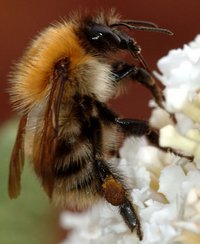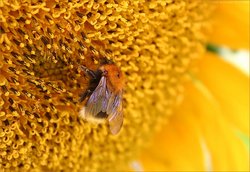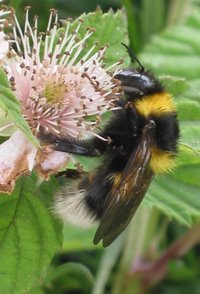Bumblebee
The bumblebee is a flying insect of the genus Bombus in the family Apidae. more...
Like the common honeybee, of which it is a relative, the bumblebee feeds on nectar and gathers pollen to feed its young. These creatures are beneficial to humans and the plant world alike, and tend to be larger than other members of the bee family. Most, but not all, bumblebee species are gentle. From this comes their original name: "Humblebee".
Bumblebees are social insects that are characterized by a black and yellow striped body, a commonality among the majority of the species of Bombus; however, some species are known to have orange or even red on their bodies. Another distinguishing characteristic is a hairlike substance, called pile, that covers their entire body, making them appear and feel fuzzy. Queen and worker bumblebees can sting. Their sting is not barbed like that of the honeybee, so they can sting more than once.
A long-held myth of the bumblebee was that, in terms of theoretical aerodynamics, it did not have the capacity (in terms of wing size or beat per second) to achieve flight with the degree of wing loading necessary. This myth became popular after an aerodynamicist in the 1930s stated that a bumblebee was not capable of flight. The statement was based upon an assumption that the bee's wing could be treated as a static aerofoil. However, in reality the bumblebee's flight is characterized by an oscillating wing that shares more characteristics with a helicopter rotor than an aeroplane wing.
Bumblebees are typically found in higher latitudes that range from warm to cold climates where other bees might not be found. One reason for this is that bumblebees are one of the few insects that can regulate their body temperature, via both solar radiation and via internal mechanisms of "shivering" and radiative cooling from the abdomen.
Bumblebees form colonies, like honeybees. However, their hives are usually much less extensive than those of honeybees, because of the small size of the nest. Often, bumblebee nests will hold fewer than 50 individuals, and may be within tunnels in the ground made by other animals.
Unlike honeybees, bumblebees only store a few days' worth of food and so are much more vulnerable to food shortages. However, because bumblebees are much more opportunistic feeders than honeybees, these shortages may have less profound effects. Bumblebees mostly do not preserve their nests through the winter, though some tropical species live in their nests for several years. The last generation of summer includes a number of queens who overwinter separately in protected spots.1
In the autumn, young queens mate with male drone bees and hibernate over the winter in a sheltered area, whether in the ground or in a man-made structure. In the early spring, the queen awakens and finds a suitable place to create her colony, and then builds wax pots in which to lay her fertilized eggs from the previous winter. The eggs that hatch are female workers, and in time the queen populates the colony, with workers feeding the young and performing other duties similarly to honeybee workers.
Bumblebees are beneficial to human beings because they can pollinate plant species that other pollinators cannot by using a technique known as buzz pollination. For example, bumblebee colonies are often emplaced in greenhouse tomato production, because the frequency of buzzing that a bumblebee exhibits effectively pollinate tomatoes.
The agricultural use of bumblebees is limited to pollination. Because bumblebees do not overwinter the entire colony, they are not obliged to stockpile honey, and are therefore not useful as honey producers, although the honey is delicious.
Bumblebees are in danger in many developed countries due to habitat destruction and collateral pesticide damage. In Britain, there are 21 species of native bumblebee and six varieties of cuckoo bees — bees that dupe other bumblebees into looking after their young. Of these, only six bumblebees remain widespread; five are in serious decline and at least three are extinct.1
Bumblebees are increasingly cultured for agricultural use as pollinators.
Species
- Small Garden bumblebee, Bombus hortorum
- Large Garden bumblebee, Bombus ruderatus
- Cullem's bumblebee, Bombus collamanus
- Short-haired bumblebee, Bombus subterraneus
- Great Yellow bumblebee, Bombus distinguendus
- Shrill Carder bee, Bombus silvarum
- Large Earth Bumblebee, Bombus terrestris
- Bombus affinis
- Bombus bimaculatus
- Bombus borealis
- Bombus griseocollis
- Bombus fervidos
- Bombus impatiens
- Bombus insularis
- Bombus lucorum
- Bombus lapidarius
- Bombus pascuorum
- Bombus pennsylvanicus
- Bombus perplexus
- Bombus polaris
- Bombus pratorum
- Bombus rufocinctus
- Bombus ternarius
- Bombus sylvicola
- Bombus vagans
Read more at Wikipedia.org




